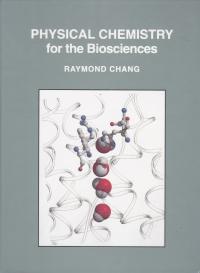Physical Chemistry for the Biosciences
Physical Chemistry for the Biosciences
By: Raymond Chang
Physical Chemistry for the Biosciences has been optimized for a one-semester introductory course in physical chemistry for students of biosciences.
For all sales outside of the United States, please contact Felicity Henson, fhenson@aip.org
Title information
Chang’s newest text has been shortened, streamlined and optimized for a one-semester introductory course in physical chemistry for students of biosciences. Most students enrolled in this course have taken general chemistry, organic chemistry, and a year of physics and calculus. Only basic skills of differential and integral calculus are required for understanding the equations. For premedical students, this text will form the basis for taking courses like physiology in medical school. For those intending to pursue graduate study in biosciences, the material presented here will serve as an introduction to topics in biophysical chemistry courses, where more advanced texts such as those by Gennis, van Holde, and Cantor & Schimmel are used. The author’s aim is to emphasize understanding physical concepts rather than focusing on precise mathematical development or on actual experimental details. The end-of-chapter problems have both physiochemical and biological applications.
Table of Contents
Chapter 1 Introduction
Chapter 2 Properties of Gases
Chapter 3 The First Law of Thermodynamics
Chapter 4 The Second Law of Thermodynamics
Chapter 5 Solutions
Chapter 6 Chemical Equilibrium
Chapter 7 Electrochemistry
Chapter 8 Acids and Bases
Chapter 9 Chemical Kinetics
Chapter 10 Enzyme Kinetics
Chapter 11 Quantum Mechanics and Atomic Structure
Chapter 12 The Chemical Bond
Chapter 13 Intermolecular Forces
Chapter 14 Spectroscopy
Chapter 15 Photochemistry and Photobiology
Chapter 16 Macromolecules
Appendices
Glossary
Answers to Even-Numbered Computational Problems
Index
|
“This is an excellent text for our undergraduate bioscience students who require advanced training in physical chemistry. It is primarily a physical chemistry textbook, and it does not scrimp on the key concepts of thermodynamics, kinetics, and molecular quantum mechanics. At the same time, the presentation style is clear and understandable, and the text is sprinkled with just enough biochemistry to maintain our students’ interest.” “Raymond Chang has flawlessly condensed the fundamental concepts of Physical Chemistry clearly and concisely in a one-semester text, giving insightful illustrations that make intuitive sense to the reader. This text applies concepts in a way that will positively impact how Physical Chemistry is taught to students in the biological sciences.” “I searched in vain for a suitable one-semester P. Chem. textbook. With the publication of Physical Chemistry for the Biosciences by Raymond Chang, I now have a textbook that is just the right step up from what the students covered in General Chemistry with a focus appropriate for students going into the pre-medical sciences.” “Having read the text closely, I am most impressed by the enormous effort Raymond Chang has made in producing a very user-friendly text and the pains to which he has gone to explain all concepts as clearly as possible.” “In his new text, Chang clearly explains the fundamental principles of physical chemistry with an emphasis on biological systems. The mathematical derivations and examples are straightforward and easy to follow for undergraduate students.” |
Raymond Chang
Raymond Chang was born in Hong Kong and grew up in Shanghai and Hong Kong, China. He received his B.Sc. degree in chemistry from London University, England and his Ph.D. in physical chemistry from Yale University. After doing postdoctoral research at Washington University and teaching for a year at Hunter College of the City University of New York, he joined the chemistry department at Williams College. Chang has served on the American Chemical Society Examination Committee and the Graduate Record Examination (GRE) Committee. He has also served as editor of The Chemical Educator and has authored books on general chemistry and spectroscopy.

